Central Valley's Only Pediatric Hospital Gaining Battery Storage Microgrid Installation
A renowned pediatric care hospital in the agricultural hotbed of northern California is going to shore up its energy resiliency with a battery storage microgrid system installed over the next three years.
The project will support Valley Children’s Hospital in Madera. Long known as a highly ranked children’s acute-care facility and teaching hospital for the Stanford University School of Medicine, Valley Children’s Hospital is installing long-duration zinc-bromine flow batteries to backup power in a region known for blackouts and grid failures due to wildfires and other extreme weather events.
Australian firm Redflow was selected to deliver the 34.4-MW battery storage system in collaboration with Faraday Microgrids.
Financing comes from the U.S. Department of Energy-supported Long Duration Energy Storage (LDES) $325 million fund and from the California Energy Commission. Redflow will begin battery installation in 2025 and continue through the following year.
Zinc-bromine flow batteries are not as common on the energy storage market as lithium-ion systems, but they offer longer duration and less fire risk, according to reports.
They also “are ideally suited for daily use in the Central Valley’s extreme heat,” Redflow CEO and Managing Director Tim Harris said in a statement. “This combination of our technology leadership, Faraday’s trusted microgrid solutions, and the funding provided by the CEC and DOE all assist in transitioning communities to a cleaner, more energy-efficient future. We are delighted to see another project from our fast-growing pipeline of opportunities progress forward and ultimately support another community with renewable energy.”
The Children’s Hospital Resiliency Grid with Energy Storage (CHARGES) project will assist Valley Children’s in delivering backup power, sustainability, and resiliency during utility outages and shortages. Operational sustainability is mission-critical for the sole full-service pediatric hospital facility in the Central Valley, according to reports. The hospital has been lauded for its pediatric acute care in a wide range of areas, including pediatric diabetes, urology, surgery and gastroenterology, according to U.S. News and World Report rankings.
Mission Critical Microgrids are on the Rise
For Hospitals, Military Bases, Universities and Data Centers
Microgrid 2024 is looking for case studies and sessions around those Mission Critical Projects
Deadline to Submit Session Ideas is Oct. 2: Microgrid 2024 is April 22-24 in Baltimore
In addition to the Redflow batteries, Faraday Microgrids will pair the system with other renewable and distributed energy resources (DERs) to help provide alternatives to grid connection, replace diesel backup generators and reduce carbon emissions.
“We’ve set strong performance goals for this installation,” Faraday CEO David Bliss said in the release. We’re confident in our partnership’s capabilities to successfully deliver large, resilient, dispatchable 24/7 clean energy microgrids to health care facilities, tribes and other large grid customers throughout California and the United States.”
The Central Valley of California is one of the nation's fastest growing regions and has more than seven million residents. Valley Children's Hospital has been known as the only dedicated pediatric acute-care facility in the area.
Redflow and Faraday Microgrids also are partnering on microgrid work to provide 20-MWh zinc-based battery storage and 5-MW solar capacity for the Paskenta Band of Nomlaki Indians also in California.
Given the mission critical nature of hospitals, many in that sector see microgrids as key resiliency component of energy supply. The Hospital Building Safety Board and others are exploring microgrids as on-site power solutions for the future of the healthcare facilities.
Track news about microgrids. Subscribe to the free Microgrid Knowledge Newsletter.








